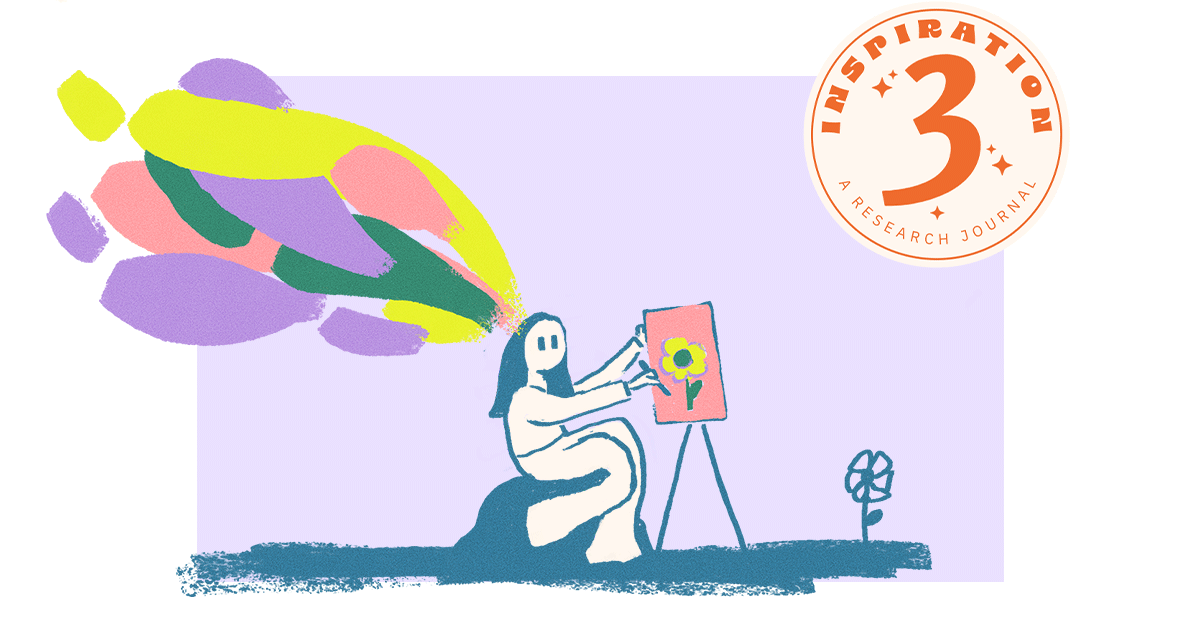1% inspiration and 99% perspiration, or so they say.
Investigating the Interplay of Inspiration and Sweat Equity in the Creative Process
Inspiration, often considered the beginning of the creative process, is undoubtedly significant in creativity and artistic expression. But those who have toiled away at creative projects know that inspiration is only a tiny part of the process. This is precisely why inspiration is often overlooked or rushed through at the beginning of a project.

Psychologist Mihaly Csikszentmihalyi sheds light on the historical attribution of creativity to supreme beings or gods, a belief that once prevailed, deeming creation a divine prerogative. In ancient Greek religion and mythology, the Muses are the inspirational goddesses of literature, science, and the arts. They were considered the source of the knowledge embodied in the poetry, lyric songs, and myths related orally for centuries in ancient Greek culture.1
However, there has been a notable shift in perspective over time as humans have come to acknowledge themselves as creators.2 This change signifies a cultural and psychological evolution, emphasizing human agency in shaping the modern world and recognizing our active involvement in creative and innovative processes across various domains and fields. This is how humans have operated for much of recent history, as the makers of our destiny, the creators of the future.
Humans taking over the creator title highlights a fundamental shift in understanding creativity and the ability to find inspiration as an inherent human capacity rather than a divine gift bestowed upon a select few. Yet, we still refer to people as “creative geniuses” or “born with creative talent,” therefore singling out individuals as having inherent gifts. I could write another post about this contradiction, so I will focus on this human capacity more broadly, in the sense that we all possess the ability to find inspiration in our daily lives.
When finding inspiration, we often feel that it must come from external sources rather than within ourselves. While inspiration usually comes from influence—such as a great song, a beautiful sunset, or a painting from your favorite Renaissance artist—these are all external forces. A beautiful sunset is an inspiration from nature; a song is an inspiration from another artist. Our inherent human capacity — the critical shift that Csikszentmihalyi talks about — is the ability to decipher and filter out these external forces and then apply the concepts or themes we like to our creative work.
This perspective aligns with the recognition that inspiration – often synonymous with a new idea, illumination, or insight – plays a crucial role at the outset of the creative process, driving individuals to embark on creative activities.
As illustrated by the discussion in psychology and the social sciences: “In accounts of the creative process, we seem either to be waiting for inspiration to get us started or for that moment of discovery that will constitute a breakthrough in the way we have been thinking about a problem, often described as an ‘illumination’”3. Inspiration itself encompasses the broader experience of being mentally stimulated to engage in innovative thinking or to experience a surge of creativity.
So why is inspiration often overlooked in the creative process? Why focus on such a tiny, seemingly insignificant spark? Why do we usually find ourselves waiting for inspiration to get us started? In contemplating the often-overlooked essence of inspiration within the creative process, we grapple with profound questions about its significance and our perpetual reliance on it as a catalyst for creative endeavors.
Inspiration drives innovative thinking and creativity. It represents human ingenuity and imaginative ability. And while it is a tiny part of the overall creative process, it should not be overlooked.
It’s fascinating to think that the ancient Greeks developed characters/gods to represent the inspirational forces behind different art forms: the nine muses. I write more about muses here, and you could also check out this source for more information on them.
CSIKSZENTMIHALYI, Mihaly. 2009. Creativity: Flow and the Psychology of Discovery And. Harper Collins.
HART, Tobin. 1998. “Inspiration: Exploring the Experience and Its Meaning.” Journal of Humanistic Psychology 38(8), 7–35.






I really like the inspiration/perspiration GIF…a great visual to keep the ratio ever present in my mind.